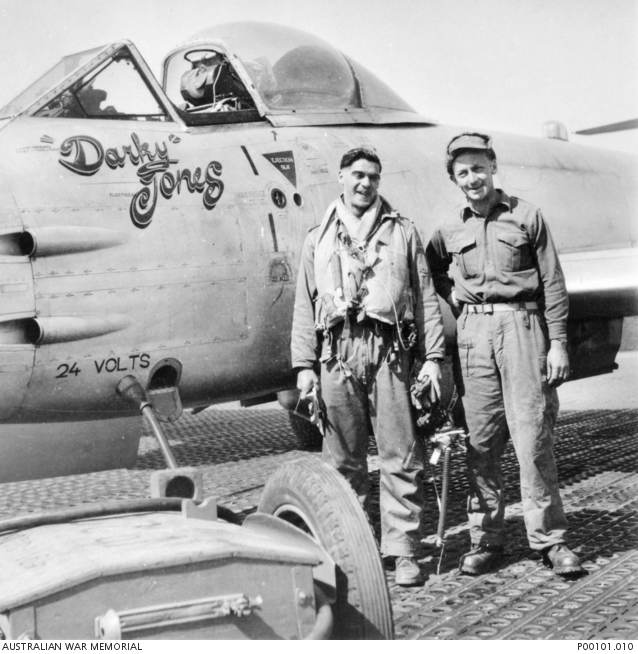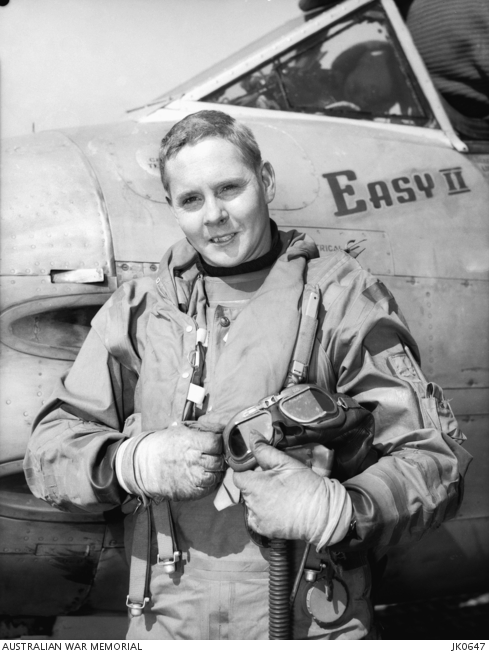War Paint: Australian Nose Art over Korea
During the Korean War, No. 77 Squadron, Royal Australian Air Force (RAAF) had a diverse range of nose art on their Mustangs and Meteor aircraft. From rank emblems and names applied in cursive red font to more ornate artworks including cartoons and sporting emblems, the unit continued the tradition of applying nose art to wartime Australian military aircraft.
It is likely that the Australian approach to nose art, more conservative than the boisterous –often risqué – style of American squadrons, saw less nose art appear on No. 77 Squadron aircraft at the start of the Korean War.
The most common early form of nose art was a simple red cursive font – likely applied using the same red paint used in the red, white and blue RAAF roundels that appeared on Australian aircraft –presenting names such as “Rosemary”, “Leonie”, “Robyn”, “Shirley”, “Amber” and “Margie”. More complex and illustrative nose art appeared later, used by the pilots to represent their families, friends, nicknames and home towns in Australia.
Here is a selection of photographs from the Memorial’s collection, showing examples of nose art applied to RAAF aircraft that served over Korea.
Kimpo, South Korea c. March 1954. Starboard view of the cockpit of No. 77 Squadron, RAAF Meteor no. A77-853.
Kimpo, South Korea. 1952. Wing Commander Ronald Susans, Commanding Officer of No. 77 Squadron, RAAF. The nose art “Mart & Geoff” refers to Susans’ sons. JK0281B
Pilot Officer Randall Green prepares for a mission against communist targets in North Korea with No. 77 Squadron, RAAF. The nose art on his aircraft (A77-316) refers to Sergeant James Kichenside who served at Kimpo from March to September 1952, completing 148 operational missions. The youngest pilot in the squadron, he was known as “the Korean Kid”. On 27 August 1952, A77-316 was piloted by Flying Officer Olaf Bergh from RAF and was hit by ground fire. Bergh ejected safely and spent the remainder of the conflict as a prisoner of war.
Sergeant James Kitchenside beside his allocated Meteor, A77-316 “The Korean Kid” in 1952.
Kimpo, South Korea in April 1953. “Old 859 and her crew”, Sergeant Ted Jones with No. 77 Squadron, RAAF ground technician and his aircraft, “Darky Jones”.
Kimpo, South Korea. 1952. Flying Officer Ross Frayne, No. 77 Squadron, RAAF.
Kimpo, South Korea, 1953. Warrant Officer Bob Turner waits in the cockpit of his Meteor for the word to go. The name of the aircraft is either “Au’s Job” or “Au’s Jol”.
Kimpo, South Korea in April 1952. Ground crew of No. 77 Squadron, RAAF eagerly want to know the score. The pilot is Warrant Officer Bob Turner and the aircraft is named “Elyane”.
Kimpo, South Korea in 1953. Flying Officer John Price, a Royal Air Force pilot flying with No. 77 Squadron, RAAF leaves his aircraft after an operational mission against communist supply routes in North Korea.
Kimpo, South Korea in 1953. RAF Flying Officer A.J. Rosser and RAAF Flight Lieutenant Vivian Shearn chat in front of Shearn’s Meteor, nicknamed “Betty Toot”.
Kimpo, South Korea in 1953. Sergeant George Hale (left) briefing his brother, Corporal Vernon Hale from the 3rd Battalion, the Royal Australian Regiment, before taking off on a practice flight in No. 77 Squadron RAAF’s two seat Meteor T.7 “Leonie”.
Kimpo, South Korea in 1953. Sergeant George Hale after a brush with MiG fighters over North Korea on 27 March 1953.
Kimpo, South Korea in 1953. Warrant Officer Bob Turner with his Meteor jet on which he had the South Australian state crest and his wife’s name painted.
Interstate footballer Sergeant Geoff Collins standing near his Meteor aircraft. Sergeant Collins has a lance-wielding demon as his aircraft nose art. The demon is the symbol of the Melbourne Football Club.
Sergeant Philip Zupp, a pilot of No. 77 Squadron, RAAF in the cockpit of a Gloster Meteor named “Black Murray” during conversion training. The aircraft was named for Pilot Officer Kenneth “Black” Murray, a No. 77 Squadron pilot who flew 333 missions, the largest number of missions flown by any United Nations pilot in Korea.
Leading Aircraftman Paul Cherry sitting in the seat of “Black Murray”. This aircraft held the record for the most number of missions with the United States 5th Air Force, who flew Sabres at Kimpo. On 16 February 1952, the aircraft was hit by ground fire and broke up at low altitude in the Haeju area.
Korea c. 1952. Royal Air Force Pilot John Mellers in a Gloster Meteor named “Querida Mia” at Kimpo airfield. The name means “my beloved” or “my darling” in Spanish.
Kimpo, South Korea, c. March 1954. Flying Officer Donald Hampton holding his flying helmet as he stands beside Meteor aircraft A77-446 on the airstrip. The aircraft has “Marara I” nose art beneath the cockpit.
Kimpo, South Korea, c. March 1954.Port side view of the cockpit of a No. 77 Squadron RAAF Meteor jet.
Kimpo, South Korea c. February 1954. No. 77 Squadron, RAAF ground crew attending a Meteor Jet fighter on its return. The aircraft number is A77-891 and has the name “Margery I” beneath the cockpit.
Kunsan, South Korea in c. February 1954. Informal portrait of Leading Aircraftman Brian Chamberlain standing beside a Meteor aircraft numbered A77-855. The aircraft has “Boots” nose art below the cockpit.
Iwakuni, Japan in 1954. Port side view of a cockpit of a Douglas C47 Dakota transport aircraft. The crest of No. 36 Transport Squadron has been painted below the co-pilot’s window.
Kunsan, South Korea, 1954. A No. 77 Squadron, RAAF Meteor jet fighter, numbered A77-865 in the dispersal area of the RAAF base. The nose art below the cock pit says “Curly Bloodnut”.
Korea c. 1952. Pilot Officer Bill Simmonds in his Meteor at Kimpo airfield.
























